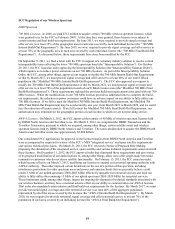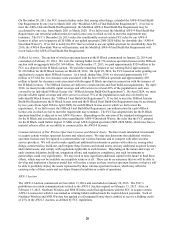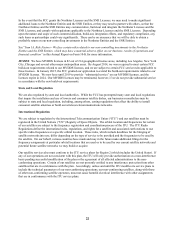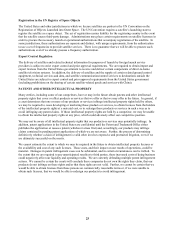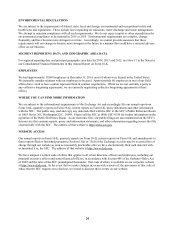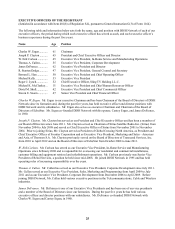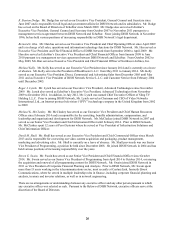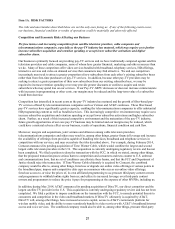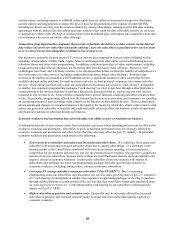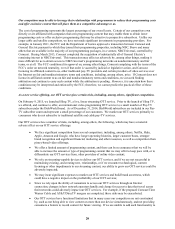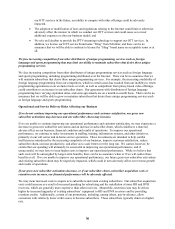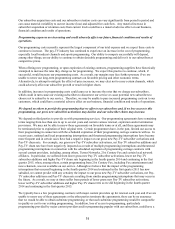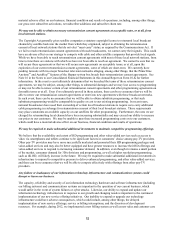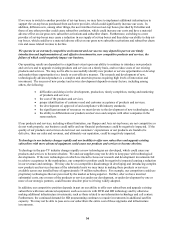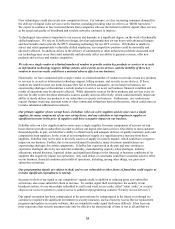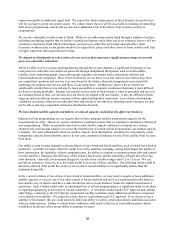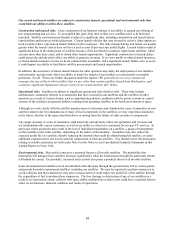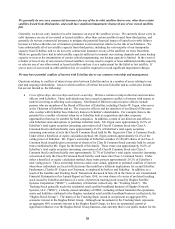Dish Network 2014 Annual Report Download - page 39
Download and view the complete annual report
Please find page 39 of the 2014 Dish Network annual report below. You can navigate through the pages in the report by either clicking on the pages listed below, or by using the keyword search tool below to find specific information within the annual report.29
29
Our competitors may be able to leverage their relationships with programmers to reduce their programming costs
and offer exclusive content that will place them at a competitive advantage to us.
The cost of programming represents the largest percentage of our overall costs. Certain of our competitors own
directly or are affiliated with companies that own programming content that may enable them to obtain lower
programming costs or offer exclusive programming that may be attractive to prospective subscribers. Unlike our
larger cable and satellite competitors, we have not made significant investments in programming providers. For
example, in January 2011, the FCC and the Department of Justice approved a transaction between Comcast and
General Electric pursuant to which they joined their programming properties, including NBC, Bravo and many
others that are available in the majority of our programming packages, in a venture, NBCUniversal, controlled by
Comcast. During March 2013, Comcast completed the acquisition of substantially all of General Electric’s
remaining interest in NBCUniversal. This transaction may affect us adversely by, among other things, making it
more difficult for us to obtain access to NBCUniversal’s programming networks on nondiscriminatory and fair
terms, or at all. The FCC conditioned its approval on, among other things, Comcast complying with the terms of the
FCC’s order on network neutrality, even if that order is vacated by judicial or legislative action, and Comcast
licensing its affiliated content to us, other traditional pay-TV providers and certain providers of video services over
the Internet on fair and nondiscriminatory terms and conditions, including, among others, price. If Comcast does not
license its affiliated content to us on fair and nondiscriminatory terms and conditions, we can seek binding
arbitration and continue to carry such content while the arbitration is pending. However, it is uncertain how these
conditions may be interpreted and enforced by the FCC; therefore, we cannot predict the practical effect of these
conditions.
As a new service offering, our OTT services face certain risks, including, among others, significant competition.
On February 9, 2015, we launched Sling TV, a live, linear streaming OTT service. Prior to the launch of Sling TV,
we offered, and continue to offer, an international video programming OTT service to a small number of Pay-TV
subscribers under the DishWorld brand. As of December 31, 2014, DishWorld subscribers are included in our Pay-
TV subscriber count and represent a small percentage of our customers. We market our OTT services primarily to
consumers who do not subscribe to traditional satellite and cable pay-TV services.
Our OTT services face a number of risks, including, among others, the following, which may have a material
adverse effect on our OTT service offerings:
We face significant competition from several competitors, including, among others, Netflix, Hulu,
Apple, Amazon and Google, who have longer operating histories, larger customer bases, stronger
brand recognition and significant financial, marketing and other resources, as well as competition from
piracy-based video offerings;
We offer a limited amount of programming content, and there can be no assurances that we will be
able to increase the amount or type of programming content that we may offer to keep pace with, or to
differentiate our OTT services from, other providers of online video content;
We rely on streaming-capable devices to deliver our OTT services, and if we are not successful in
maintaining existing, and creating new, relationships, or if we encounter technological, content
licensing or other impediments to our streaming content, our ability to grow our OTT services could be
adversely impacted;
We may incur significant expenses to market our OTT services and build brand awareness, which
could have a negative impact on the profitability of our OTT services;
Since we rely upon the ability of consumers to access our OTT services through an Internet
connection, changes in how network operators handle and charge for access to data that travel across
their networks could adversely impact our OTT services. For example, if the proposed Comcast/Time
Warner Cable and AT&T/DirecTV mergers are completed, these risks may be exacerbated;
Our OTT services have functional limitations that in many cases our competitors are not constrained
by, such as not being able to view content on more than one device simultaneously, and not providing
consumers a feature to record content for future viewing. If we are unable to add such functionality to


